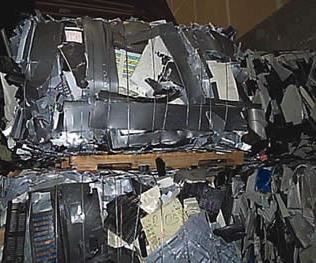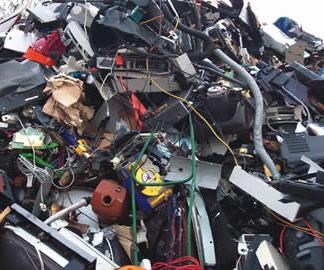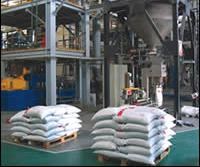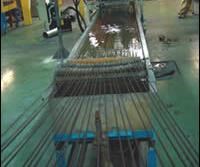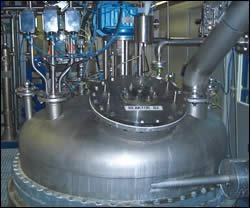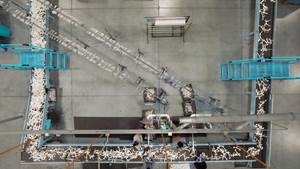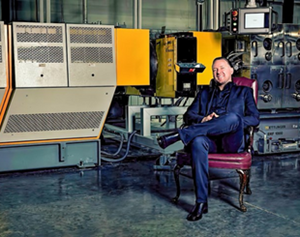Recycling E-Plastics New Material Stream Brings Its Own Set of Problems
Brominated flame retardants restrict its use. Most now goes to China, but new recycling processes promise to ‘clean up’ e-waste.
Ewaste—today’s term for discarded computers, monitors, hard drives, copiers, printers, fax machines, telephones of all types, and even televisions—is collected in large volumes in this country, but not always for its intrinsic value as recyclable raw materials. Printed-circuit boards contain more than $3/lb in recoverable metals, but that’s offset by the disposal cost of low-value and hazardous materials.
Two factors currently drive e-waste collection and recycling. Corporations want to ensure data security by destroying their old computers. Governments around the world support, or require, e-waste collection because of the hazardous metals and chemicals in many components. Since 1993, the U.S. EPA has defined CRT tubes and LCD screens as hazardous because they contain leaded glass and mercury, respectively. PC’s contain circuit boards with heavy-metal components and rechargeable lithium batteries.
Plastics from old computers contain brominated FRs, making them unusable in Europe under new RoHS restrictions. (Photo: WM Recycle America)
But the largest volume component of electronic scrap is the “e-plastics,” some of which contains brominated flame retardants. Personal computers contain the most—as much as 2.62 lb of FR agents in the cabinet and another 1.13 lb in the circuit boards—according to a report from the Univ. of British Columbia, Vancouver, published in the February issue of Resource Recycling magazine.
According to the EPA, 57 million computers were sold in the U.S. last year. The average life of a PC nowadays is two or three years. So that’s a lot of troublesome waste.
The European Union’s new RoHS regulations on “restriction of the use of certain hazardous substances in electrical and electronic equipment,” which took effect in 2006, limit the amount of brominated FR in plastics to no more than 0.1% of polybrominated biphenyls (PBB) and polybrominated diphenyl ethers (PBDE). Although newer electronics are being made with nonhalogen FRs, there’s still a lot of older equipment out there. That makes recycled e-plastics largely unusable by any company selling its products in Europe. And that effectively makes closed-loop recycling of e-plastics impractical.
What’s a recycler to do?
“Recyclers are dependent on what’s available in the market. If RoHS prohibits reuse of these materials, then what do we do with those products?” asks Darren Arola, global sales director at MBA Polymers, a U.S.-based recycler of e-plastics and plastics from other durable goods. MBA has operated joint-venture recycling plants in China since 2005 and in Austria since 2006. They produce recycled ABS, HIPS, and PP that are equivalent in purity and consistency to virgin materials, Arola claims. But MBA mostly avoids FR materials if it can help it because end-use markets are so hard to find.
MBA qualifies its e-waste suppliers and tests incoming plastics for composition and FR level. MBA prefers to source materials from low-voltage appliances and electronics that don’t have a CRT and thus don’t require flame retardants—like phones, printers, and refrigerators.
Material collected under European WEEE directives combines electronic products with many other electrical goods. (Photo: Axion)
Axion Polymers, a recycler of e-plastics in the U.K., also tests incoming materials and removes polymers with brominated FRs. “E-waste containing circuit boards, as well as TV and computer-monitor casings, photocopiers, and other high-voltage items are the particularly controversial components of the e-waste mix, where there is a high proportion of bromine,” says Axion director Roger Morton. The brominated FR material has only low-value markets, he adds.
Just how low that value is to recyclers is demonstrated by one U.S. firm that sells unseparated e-waste mixture for 2¢/lb to a local auto shredder, which commingles it with auto-shredder fluff. This is used as a daily cover at a local sanitary landfill, avoiding the use of “good dirt.”
What really supports e-waste recycling is data destruction by large corporations. When they replace electronic equipment, they pay to guarantee destruction of their old computers to protect confidential data. That makes available large numbers of microchips and hard disks from which precious metals can be recovered. In addition, reclaimers are increasingly finding that refurbishing and reselling whole used computers and monitors is a higher value reuse market than salvaging the raw materials they contain.
The growing pile
But after the destruction of hard drives and memory chips, refurbishing of whole computers, recovery of valuable metals, and removal of hazardous glass, what’s left is a growing pile of plastic shells from monitors, printers, fax machines, and TVs that can be reused only if it’s separated by polymer type and FR content.
Because e-plastic waste is a new material for regulators, collectors, recyclers, and end users, record keeping is still fairly rudimentary. The Institute of Scrap Recycling Industries (ISRI) in Washington, D.C., which started tabulating e-waste just this year, calculates that the U.S. generated 1.5 billion lb of all kinds of e-waste in 2006, of which an estimated 10% was recycled. According to the 2006 report of the International Association of Electronics Recyclers in Albany, N.Y., U.S. electronics recyclers processed 2.8 billion/lb of e-waste in 2005. Of that, around 245 million/lb of plastics were recycled in some manner.
Two U.S. states and one Canadian province require computer recycling—California since 2005, Maine and Alberta since 2006. More states and provinces are gearing up. The California Integrated Waste Management Board in Sacramento has approved 53 computer dismantlers and over 400 collection centers, which processed nearly 127.6 million lb of e-waste last year. European WEEE (Waste Electrical and Electronic Equipment) directives since 2006 also require collection of electronics and electrical appliances.
Gone to China
Because of the FR issue, e-plastics waste has found applications mainly in China. While there is no hard data available, probably 99% of U.S. e-plastic is now baled and shipped to China to be recycled there because separation is so labor-intensive. Back in the late 1990s, the U.S. government funded attempts to develop a successful method of sorting e-plastics. Unicor, the federally sponsored prison work-training program, set up a pilot project in Lewisburg, Pa., to figure out how e-plastic parts could be manually separated for reuse—and concluded that it couldn’t be done cost-effectively. Unicor now ships baled plastics from its electronics dismantling facilities around the country to brokers and consolidators to be sent to China.
Fortune Metals and Plastics, a large U.S. reclaimer with 25 facilities in the U.S., Mexico, Hong Kong, and mainland China, set up a Chinese joint venture in Nanjing 10 years ago to sort and upgrade e-waste metals and plastics. It has added three more Chinese plants since then. The Nanjing plant is ISO 9001 and ISO 14001 certified, and Fortune provides workers there with food, housing, and medical care.
Parc Corp. in N. Aurora, Ill., is an e-plastic consolidator. It was set up six years ago to buy plastic shells of old TVs and monitors after the glass and metal are removed and ship them to China. Parc sends e-plastics to its own recycling facility in QingDao, northern China, where the material is sorted, metal fasteners are snipped out, and the plastic pieces are hand washed. “They can sort PC/ABS, ABS, or HIPS with up to 80% purity by identifying the manufacturer visually,” says Parc v.p. of sales, Bei Guan. A “burn test” with a lighter will distinguish ABS from PC/ABS. The resins are pelletized and used on the local market to mold products like housings for low-end appliances such as water coolers.
Imperfectly sorted e-plastics could raise potential quality and health issues. A mixture of e-plastics contains different FR agents used in ABS, HIPS, and PC/ABS of different vintages. The most common brominated FR agent still used today is decabromodiphenyl oxide (DBDPO), which is not considered an environmental or health hazard in waste plastics. But older e-waste could contain octa- and pentabrominated biphenyls—FRs now banned as environmental hazards.
Taming the FR problem
Axion Recycling Ltd., a U.K. recycling consultant, is working with WRAP (Waste Resources Action Program) a government-funded recycling development group in Banbury, Oxon, U.K., to test ways to remove brominated FRs from e-plastics. WRAP has licensed the CreaSolve technology developed by the Fraunhofer Institute for Process Engineering and Packaging (Fraunhofer IVV) in Germany and also developed its own Centrevap method.
Both processes dissolve the FR polymer in a solvent, then separate the FR agents from the solution before removing the solvent again to precipitate out polymer with low FR levels. Tests at Axion showed that CreaSolve’s technology reduced brominated FR concentration down to 0.055%. The Centrevap method filters out submicron particles such as antimony oxide but does not remove the soluble FRs.
CreaSolv uses a non-VOC solvent developed by CreaCycle GmbH, Grevenbroich, Germany. This mixture of esters with high-molecular-weight components is 99% recycled in the process. “Based on production of 8 to 10 million lb/yr, the resulting polymer costs 50% less than virgin resin,” Fraunhofer says. CreaSolv technology has only been practiced on a pilot scale and is still two years away from being commercially available.
Automated e-recycling
While many Chinese e-waste reclaimers make use of plentiful and cheap manual labor, around a half-dozen recyclers and reclaimers around the world have set up systems to separate e-scrap plastic automatically. In the 1990s, Butler MacDonald Inc. (originally a metals reclaimer) developed systems using hydrocyclones and electrostatic, density, and color separators to recover 99.9% pure polymer streams from mixed regrind. For example, Butler MacDonald separates PP from PET in closed-loop reprocessing of used printer and fax cartridges for a large manufacturer.
Butler MacDonald also reprocesses a small amount of baled computer monitors, but “it’s still a very small percentage of what we do,” says v.p. Terrence Bradshaw. He notes that brokers and aggregators have to be willing to invest in equipment to remove the glass and keyboards first. Then the metals, dirt, and rocks can be extracted and finally the polymers separated automatically.
MBA’s Chinese and Austrian plants use a process that includes metal-removal devices, grinders, and air separators to remove dust, wood, rubber, and glass. Cleaned plastic flake then goes through a proprietary series of modules to separate PP, HIPS, and ABS. Purified flake streams are tested for quality and conveyed pneumatically to twin-screw compounding extruders that are custom-built for MBA in China.
MaSeR Corp. in Barrie, Ont., was set up in 2005 to reclaim metals from e-waste using automated mechanical processes that include grinding and centrifugal friction. Its three-stage process starts with coarse shredding into 6- to 8-in. pieces, after which the large chunks of plastic are removed. The remainder goes to a ring mill, then a granulator. Bonded metals and plastics are then delaminated in a proprietary mechanical device that MaSeR calls a “Fractionator.” MaSeR sells its mixed-plastics byproduct to makers of products like highway sound barriers. Some high-plastic-content electronics “cost more to run through the system than it can produce in output value,” according to the company’s website.
Plas-Sep Ltd., London, Ont., does electrostatic separation using a large rotating drum (its own development) and does toll separation for several large waste reprocessors in the region. It reportedly can separate most ABS from FR-ABS, depending on the mix proportions. The process also separates polymers of similar density. (Plas-Sep is represented in the U.S. by Bob Wolfe at Action International.)
Electrocycling GmbH in Goslar, Germany, performs elaborate mechanical separation of e-waste, primarily for metals recovery, but generates about 15 million lb/yr of e-plastic. It hand separates incoming waste and processes it in homogenous lots—i.e., all phones or all TVs—to reduce cross-contamination. Phones are made of non-FR ABS, which is sold to recyclers. Mixtures of FR plastics are sold for waste-to-energy incineration. “It’s better to incinerate than to dilute the FR material and keep it in the loop,” says Georg Froehlich, managing director.
Plastic Herverwerking Brabant in Waalwijk, The Netherlands, uses a series of steps to mechanically separate plastics collected under European WEEE rules.
Axion Recycling in the U.K. set up Axion Polymers in 2006 to perform automated separation and recycling of e-plastic scrap generated by WEEE regulations. It can process 28 million lb/yr of e-plastics via size reduction, wet and dry cleaning, automatic polymer identification and separation, and repelletizing of e-scrap plastics.
Related Content
Reversing Logistics for Plastic Film Recycling
Learn how Mainetti built a circular supply chain for clear film packaging.
Read MoreRecycling: What's Ahead in Advanced Sorting Technology
As the industry tries to ramp up recycling, there are several innovative sorting solutions in the offing—ranging from enhanced optical sorting technologies and chemical tracers to advanced solutions based digital watermarks and artificial intelligence.
Read MoreAvoid Four Common Traps In Granulation
Today, more than ever, granulation is an important step in the total production process. Our expert explains a few of the many common traps to avoid when thinking about granulators
Read MoreA Recycling Plant, Renewed
Reinvention is essential at Capital Polymers, a toll recycler that has completely transformed its operation in a short period of time.
Read MoreRead Next
Advanced Recycling: Beyond Pyrolysis
Consumer-product brand owners increasingly see advanced chemical recycling as a necessary complement to mechanical recycling if they are to meet ambitious goals for a circular economy in the next decade. Dozens of technology providers are developing new technologies to overcome the limitations of existing pyrolysis methods and to commercialize various alternative approaches to chemical recycling of plastics.
Read MoreUnderstanding Melting in Single-Screw Extruders
You can better visualize the melting process by “flipping” the observation point so that the barrel appears to be turning clockwise around a stationary screw.
Read More


